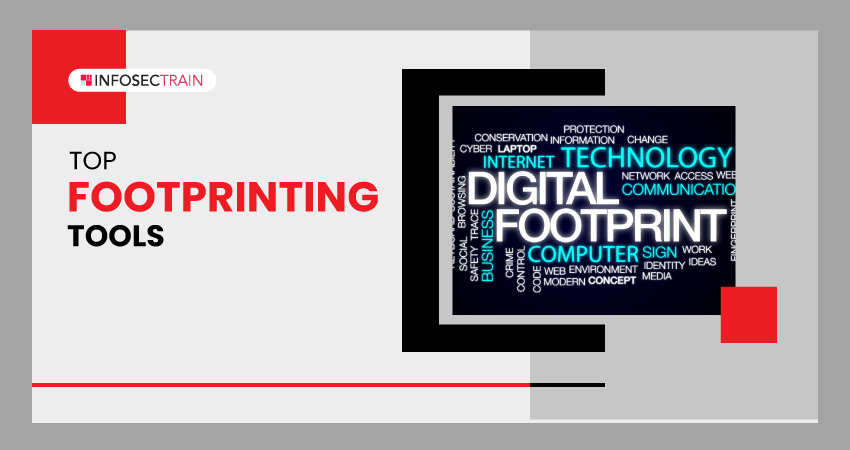Top Footprinting Tools 2024
In the intricate realm of cybersecurity, gaining in-depth insights into vulnerabilities and potential weak points within a target system or network stands as a pivotal step in building robust defense strategies. This is where footprinting tools come into play, serving as a cornerstone of reconnaissance and information-gathering processes. These tools empower cybersecurity professionals, ethical hackers, and penetration testers to explore the digital footprint of organizations and systems. By thoroughly examining public sources, network configurations, and domain landscapes, these tools offer a comprehensive view that helps identify vulnerabilities, potential attack vectors, and security gaps.

This blog delves into the top footprinting tools 2024 that play a pivotal role in bolstering digital security within our interconnected world.
What is Footprinting?
Footprinting is a systematic process of gathering information about a target system, network, organization, or individual. The data is collected from publicly available sources or through direct interactions with the target to comprehensively understand the target’s digital presence, infrastructure, and potential vulnerabilities. Accumulating this information enables cybersecurity professionals, ethical hackers, and security analysts to identify potential entry points, vulnerabilities, and security vulnerabilities.
Most Popular Footprinting Tools
Here is the list of the 10 best footprinting tools:
Open-source Intelligence (OSINT) Tools
1. TheHarvester: TheHarvester is a tool used to collect information from various open sources, including search engines, social media platforms, and domain name registries. It helps gather email addresses, hostnames, subdomains, and other pertinent information that can be useful in figuring out the target’s online presence.
2. Maltego: Maltego is a powerful Open-source Intelligence (OSINT) tool that allows analysts to visualize and understand the connections between entities such as individuals, companies, domains, IP addresses, and more. It is often used for information gathering during the reconnaissance phase of ethical hacking.
3. SpiderFoot: SpiderFoot is an open-source reconnaissance tool that automates data collection from various sources such as search engines, the dark web, domain records, social media platforms, and more. It compiles the collected data into a comprehensive report that can be used for vulnerability assessment.
Network Scanning and Analysis Tools
4. SuperScan: SuperScan is a Windows-based port scanning tool that allows users to scan a target system for open ports, services, and vulnerabilities. It provides valuable information about the network services running on a host, which helps identify potential entry points for attackers.
5. Netifera: Netifera is an open-source network security tool that combines network scanning, analyzing, monitoring, and visualization capabilities. It can help identify hosts, services, and vulnerabilities on a network.
Network and Connectivity Query Tools
6. Sam Spade: Sam Spade is a versatile network query tool that can perform various network-related tasks, such as DNS lookups, IP address searches, WHOIS queries, and more. It helps users understand the target’s connectivity and technical specifications.
7. TcpView: TcpView is a Windows-based utility that offers real-time information about active network connections, open ports, and associated processes. It helps users monitor and view details about TCP and UDP connections between their system and other systems on the network.
Web Reconnaissance Framework
8. Recon-ng: Recon-ng is a full-featured reconnaissance framework that helps gather data from different sources, such as APIs, public databases, and social networks. It offers a structured approach to information gathering and allows customization of the data collection process.
DNS Enumeration and Analysis Tools
9. DNSenum: DNSenum is a network reconnaissance tool focused on DNS enumeration and information gathering. It can identify subdomains, perform zone transfers, gather DNS-related data that might be valuable for reconnaissance, and attempt to identify potential DNS configuration errors or vulnerabilities.
Metadata and Document Analysis Tools
10. FOCA: FOCA (Fingerprinting Organizations with Collected Archives) is a Windows-based tool designed to gather and extract metadata and hidden information from various documents and files. It focuses on analyzing records, including Microsoft Office files, to extract data that can potentially disclose vulnerabilities or sensitive information.
Checkout the related blog:
- Phases of Ethical Hacking
- Reconnaissance Techniques
- How Ethical Hacking is Significant for Corporates?
You can also expand your knowledge of other tools through our blogs:
- Top Vulnerability Analysis Tools
- Top Ethical Hacking Tools Trending In 2023
- Top Tools Covered in Cybersecurity Expert Training Course
- Top Network Security Tools
- Top Tools To Manage Your Apps In The Cloud?
- Top Tools and Software for Ethical Hacking
How can InfosecTrain Help?
Gaining knowledge about footprinting holds pivotal significance within ethical hacking and penetration testing. InfosecTrain’s Certified Ethical Hacker (CEH) certification training course covers footprinting concepts to equip individuals with the essential skill set required to understand and utilize footprinting techniques, methodologies, and tools. The course teaches participants how to gather information about a target system, network, or organization using legal and ethical methods.
TRAINING CALENDAR of Upcoming Batches For CEH v13
| Start Date | End Date | Start - End Time | Batch Type | Training Mode | Batch Status | |
|---|---|---|---|---|---|---|
| 26-Apr-2025 | 01-Jun-2025 | 19:00 - 23:00 IST | Weekend | Online | [ Close ] | |
| 11-May-2025 | 28-Jun-2025 | 09:00 - 13:00 IST | Weekend | Online | [ Open ] | |
| 31-May-2025 | 06-Jul-2025 | 19:00 - 23:00 IST | Weekend | Online | [ Open ] | |
| 07-Jun-2025 | 13-Jul-2025 | 09:00 - 13:00 IST | Weekend | Online | [ Open ] | |
| 21-Jun-2025 | 27-Jul-2025 | 19:00 - 23:00 IST | Weekend | Online | [ Open ] |







 1800-843-7890 (India)
1800-843-7890 (India)